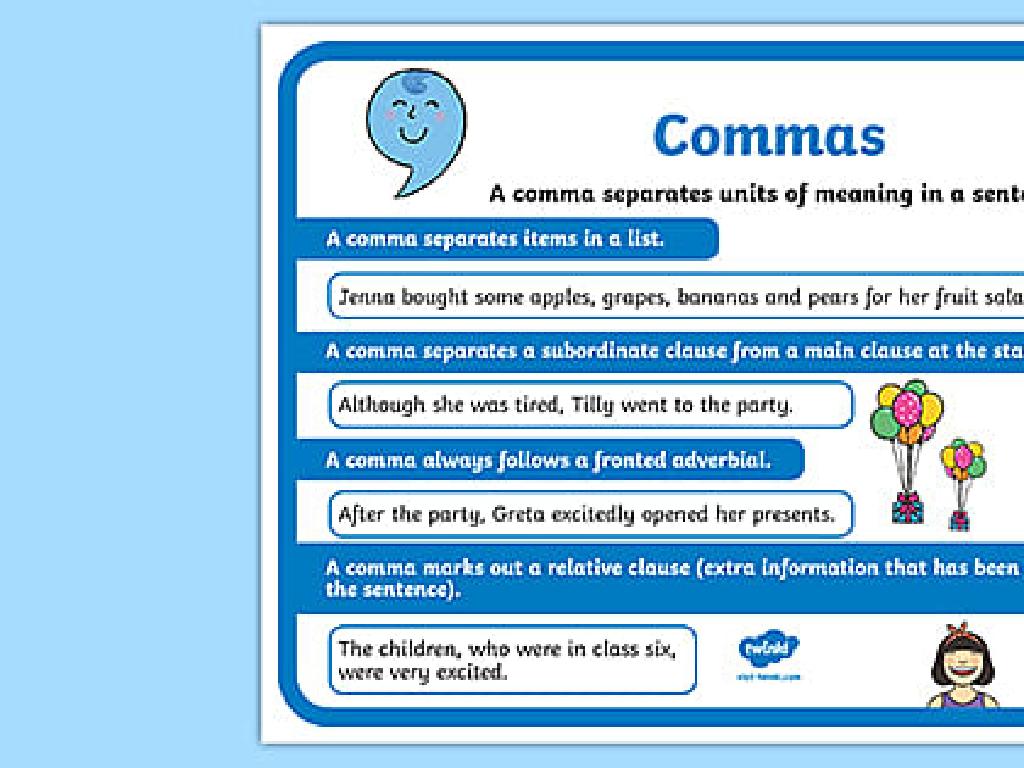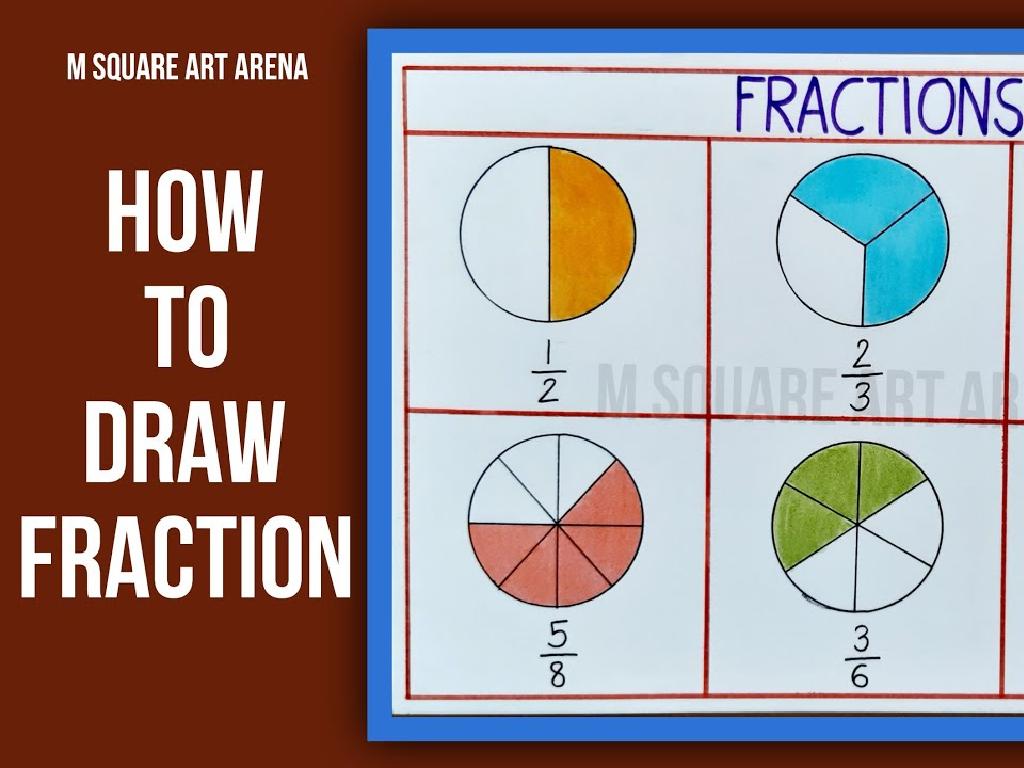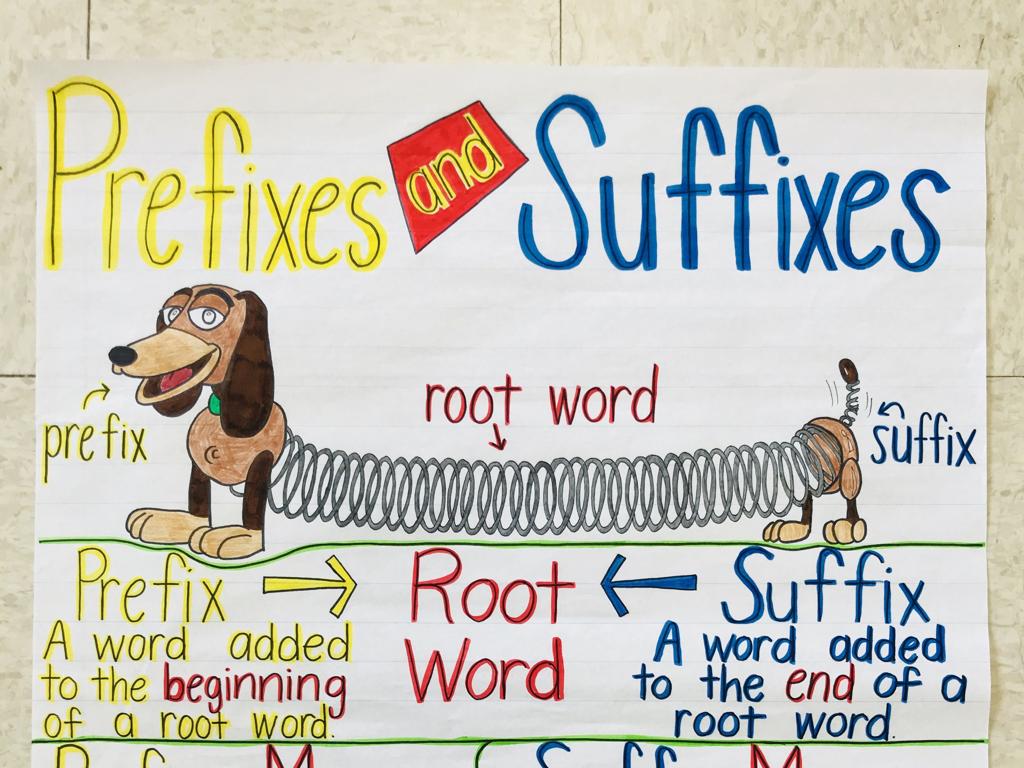Compare Information From Two Texts
Subject: Language arts
Grade: Fourth grade
Topic: Point Of View
Please LOG IN to download the presentation. Access is available to registered users only.
View More Content
Exploring Different Points of View
– Learn to compare two texts
– Understand ‘Point of View’
– ‘Point of View’ means the position from which something is observed or considered
– Importance of different perspectives
– Seeing all sides gives a fuller picture of a topic or story
– How perspectives influence understanding
– Different authors might present information in unique ways based on their perspectives
|
In today’s lesson, students will learn how to compare information presented in two different texts. They will understand the concept of ‘Point of View’ and why it’s crucial to consider different perspectives when reading. Discuss how different authors may have varying opinions or focuses, which can influence how information is presented. Emphasize the importance of recognizing these differences to gain a comprehensive understanding of a subject. Activities can include comparing two stories with the same plot but different points of view, or analyzing how different newspapers report the same event. This will help students appreciate the value of diverse perspectives in literature and media.
Understanding Point of View in Stories
– What is Point of View?
– It’s the perspective from which a story is narrated.
– Types of Point of View
– First person uses ‘I’, second person ‘you’, third person ‘he/she/they’.
– Point of View’s Effect
– How a story feels can change with different points of view.
– Comparing Points of View
– Read two stories and discuss how the point of view changes your experience.
|
This slide introduces the concept of point of view and its importance in storytelling. Explain that the point of view is like looking through the eyes of the narrator or character. Clarify the differences between first, second, and third person narration with examples. Discuss how the choice of narrator can change how the story is understood and felt by the reader. For example, a story told from a child’s perspective might seem more innocent than the same story told by an adult. Encourage students to think about how stories might change if told from a different point of view. As an activity, students can compare two texts with different points of view to understand how perspective shapes storytelling.
Comparing Texts: Understanding Different Perspectives
– What does comparing texts involve?
– It means examining two texts to understand how they are alike and different.
– Finding similarities and differences
– Look for themes, settings, characters, or events that are similar or different.
– Everyday examples of text comparison
– Comparing news articles, recipes, or stories to find the best one.
– Why comparing texts is important
– Helps us understand multiple viewpoints and make informed decisions.
|
This slide introduces the concept of comparing texts, a critical skill in language arts. Students will learn that comparing involves analyzing two pieces of writing to identify both similarities and differences in various elements such as themes, settings, and characters. Provide everyday examples, such as comparing different news articles or recipes, to make the concept relatable. Emphasize the importance of this skill in understanding different perspectives and making informed decisions. Encourage students to think critically about the information they read and to recognize that different texts may present different viewpoints on the same topic.
Comparing Texts: Key Words
– Understand ‘Similar’ and ‘Different’
– ‘Similar’ means alike, ‘Different’ means not the same
– Learn to use comparison words
– Use ‘Likewise’ to show agreement between texts
– Practice with sample sentences
– Find and highlight key words that show comparison
– ‘Both’ and ‘Unlike’ usage
– ‘Both’ shows similarity, ‘Unlike’ shows contrast
|
This slide introduces students to the vocabulary used when comparing information from two texts. Understanding words like ‘Similar’ and ‘Different’ is crucial for identifying how texts agree or differ on a topic. Teach students how to use words such as ‘Likewise’ to indicate agreement, and ‘Both’ or ‘Unlike’ to compare or contrast information. During practice, provide sentences from sample texts and guide students to identify and highlight the key words that signal comparisons. Encourage them to explain why they chose those words and what comparisons they indicate. This activity will help solidify their understanding of how to compare different points of view in texts.
Reading with a Purpose: Point of View
– Identifying main ideas
– Find the big idea of the story
– Supporting details in texts
– Look for key details that explain the main idea
– Comparing two story perspectives
– Read stories about the same event, notice how they differ
– Activity: Highlight POV differences
– Use highlighters to mark different viewpoints in the stories
|
This slide introduces students to the concept of reading with a purpose, focusing on understanding the main idea and supporting details. Students will compare two stories about the same event to identify differences in point of view. For the activity, provide two short stories that describe the same event from different perspectives. Guide the students to highlight or underline parts of the text that show the author’s unique perspective. Discuss how the same event can be seen differently by different people. This will help students understand that point of view can change how a story is told and interpreted. Encourage them to think critically about the information presented and to recognize the importance of perspective in storytelling.
Group Activity: Comparing Stories
– Read two short stories as a class
– Discuss differences in groups
– Consider characters, settings, and events
– Each group will present findings
– Focus on varying points of view
– How might different characters tell the story?
|
This group activity is designed to help students understand the concept of point of view by comparing two short stories. After reading the stories together, divide the class into small groups and assign each group to discuss how the stories differ in terms of characters, settings, events, and the narrator’s perspective. Encourage them to think about how the point of view might change if the story was told by a different character. Each group will then present their findings to the class, fostering public speaking skills and collaborative analysis. As a teacher, facilitate the discussions by guiding students with questions and ensuring each group stays on task. Possible activities could include creating a Venn diagram to visualize differences, rewriting a scene from an alternate point of view, or acting out a part of the story with a different narrator.
Class Activity: Exploring Different Perspectives
– Choose two story characters
– Write paragraphs on their viewpoints
– Imagine how each character sees the events of the story
– Partner up and share your work
– Discuss viewpoint differences
– How do their perspectives compare and contrast?
|
This activity is designed to help students understand that different characters can have unique perspectives on the same events. Students should pick two characters from a story they’ve read in class and write a short paragraph from each character’s point of view. Encourage them to think about how each character’s background and experiences might influence their thoughts and feelings. After writing, students will pair up to share their paragraphs and discuss how the characters’ viewpoints differ. This exercise will enhance their ability to analyze point of view and compare information from different perspectives. Possible stories to choose from could include ‘Charlotte’s Web’, ‘The Tale of Despereaux’, or ‘Because of Winn-Dixie’.
Conclusion & Reflection: Comparing Texts
– Value of comparing texts
It helps us see different perspectives and gain a deeper understanding.
– Understanding different views
Knowing various viewpoints improves our thinking and empathy.
– Reflect on today’s lesson
– Engage in class discussion
Let’s talk about what we learned and how we felt about it.
|
This slide aims to wrap up the lesson by highlighting the importance of comparing texts and understanding different points of view. Emphasize to students that by examining how different authors approach the same topic, they can develop critical thinking skills and a more comprehensive understanding of the subject matter. Understanding different points of view also fosters empathy and can help students in their interactions with others. Encourage a class discussion where students can share their thoughts on the lesson, what they found challenging, and what they enjoyed. This reflection will help consolidate their learning and provide valuable feedback for future lessons.
Homework: Comparing Texts
– Find two articles on the same topic
– Choose articles from different authors or publications
– Write a paragraph on different viewpoints
– How do the authors feel about the topic? What words tell you that?
– Use comparison words in your paragraph
– Words like ‘similarly’, ‘on the other hand’, and ‘however’ help compare
– Discuss your findings in the next class
|
This homework assignment encourages students to engage in critical thinking by comparing the point of view of two different articles on the same topic. Students should be guided to look for clues in the text that indicate the author’s perspective, such as tone and word choice. They should also be taught how to use comparison words to structure their paragraph effectively. In the next class, be prepared to facilitate a discussion where students can share their insights and learn from each other’s analyses. This will help them understand that different sources can have varying opinions on the same subject.






